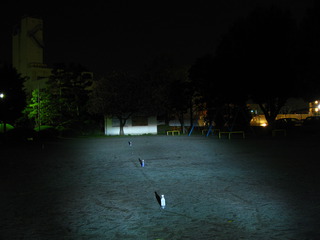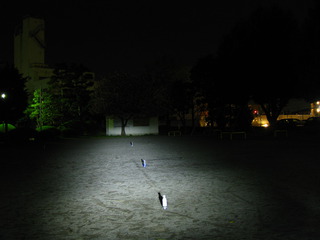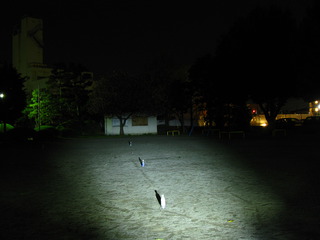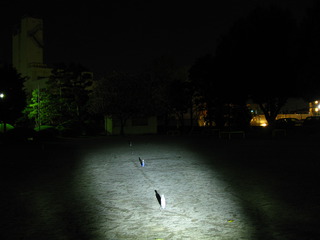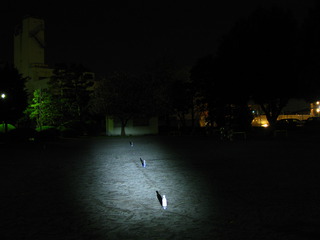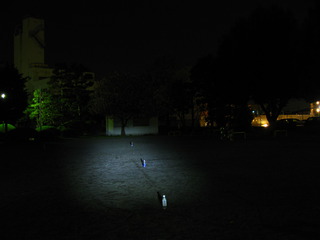Summaries of reviews of headlamps with cutoff running on batteries
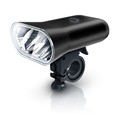
|
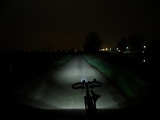
|
Tested: 1-21 August 2010, and may times after that. In Sept. 2013 I tested a new version with neutral white LEDs.
Best bike lamp I've ever seen (for on-road use), at a relatively moderate 270 lumen with its superb beam pattern and even illumination of the road surface it blows the Magicshine MJ-808, Edelux and Ktronik's dynamo powered triple XP-G away (and that's true for any other bike lamp I've tested so far except the Betty, up to Sept. 2013: Update 2015-1-6: This is still true, I have not yet seen a better headlamp). It lights up the full width of the road (at least 7 metre) and throw is about 70 m. Bad points: Some versions have a timer to swtich to low mode to make sure you can get home with light, which is set rather short, so the runtime on high is just over an hour. Further, on bad roads the lamp slightly rattles on the mount.
2013-9-27: The new version with what appear to be neutral white LEDs, was made at least since week 41 of 2012, so perhaps this was the first bicycle headlamp with neutral white LEDs? The electronics is also much improved, and the status LEDs too. This is (still) the best bicycle headlamp you can buy...
More details: Philips LED bike light (battery powered): description and review + comparison with Edelux and other lamps
No longer made since early 2014...
|

|
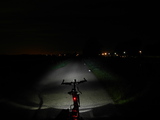
|
Tested: 29 June 2011 - 4 Dec. 2011
Interesting in that it uses a Cree MC-E running at about 5W which should give a similar amount of light to the Philips LBL, but the reflector isn't able to put enough light at the top of the beam, which means little throw. For fast nighttime riders some 2.4W dynamo lamps such as the Edelux or Philips SLD are in fact better. For those who ride at a more leisurely pace at night (say 20 km/h) this lamp is suited very well. I would then only use the low beam, which gives a very wide, very even and very bright beam which lights up the road up to about 40m. I don't like the fact that the cutoff is different for low and high modes, as this means the lamp will blind oncoming traffic in high mode once it's been setup properly in low-mode. The rules in StVZO should be changed to take a changing cutoff into account, i.e. that should not be allowed! Cyclists will likely not turn off the high beam, just like often moped riders don't do that... When using a lamp with good cutoff beam, a high beam is not needed in both cases.
More details: Q-lite QL-269
|
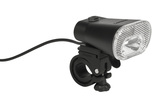
|

|
Tested: 28 Nov. 2011 - sometime early 2012
Even beam, but the plug doesn't seem sturdy enough, which gave me problems. A stronger lightbeam is desirable in many cases, so I'm not going to a buy a replacement to do further tests.
More details: Philips Saferide 40 battery
No longer made since early 2014... (but since 2017 there is the Spanninga Axendo 40 USB that is almost the same)
|

|
|
Tested: Feb. + Nov. 2012
Pedelecs are classed in 2 categories: The first is 25 km/h electric bicycles with pedal assist, the second is fast-pedelecs which can go up to 45 km/h, only allowed in some countries. This lamp is a souped up version of the Saferide 60. It was originally meant for OEMs only, but became available for loose sale in 2012 (from ca. March 2012...)
I had trouble with this headlamp as the first came without instructions, before testing the second I asked for the instructions but they can be interpreted in different ways (due to the drawings in the manual but also the input/output voltage specs printed on the lamp). These instruction really need to be changed! I have used the 2nd one on dynamo, which is possible directly, but that gives a very weak beam (far weaker than a Saferide 40 or Cyo), and when I tried it with a battery it died. New instructions were found by a reader of my website, but it was too late for me...
I'm not going to test any more samples of this lamp, what you can expect from the beam can be seen on my Saferide 60 modification/dissection page where I run the Saferide 60 with the LBL driver.
More details: Philips Saferide 80 pedelec
No longer made since early 2014...
|
Review/summary to come.
Review/summary to come.
Review/summary to come.
Review/summary to come.
Other headlamps with cutoff that run on batteries that could be of interest
The reference lamp is:
Which is the best lamp for on-road use I've seen (as of summer 2011). The rest of this page was originally part of the review of the Philips LBL, but it has expanded so much that it is worth a separate page, and here I describe all lamps with cutoff that could be of interest, but that I haven't got a sample of to review.
Busch & Müller Ixon IQ
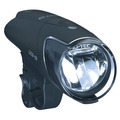
The Busch & Müller Ixon IQ was available for quite a while (since late 2007) before the Philips LED bike light and is obviously completely outclassed both in light output (it's basically a battery powered Cyo), beam shape, but also construction (Ixon = plastic, Philips = Aluminium that's also a giant heatsink), while they are nearly the same price (the Ixon IQ costs ca. €100,- with charger and 2100 mAh NiMH batteries, and the Philips costs €120,- with 2450 mAh batteries and charger), so there's really no contest here (except in runtime where the IQ is better albeit with less light). The similar Busch & Müller Ixon IQ speed is outclassed just as much in light output and construction, and those who are handy and want an external battery could do that by modifying the Philips lamp.
Dosun D1
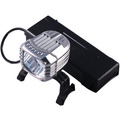
The Dosun D1 is the only other battery powered lamp with beam that has a cutoff that may be as good as the Philips lamp, that I know of. It puts out more than 500 lumen according to the manufacturer which could be real with the MC-E (which is comparable to a P7 as used in the Magicshine MJ-808 that puts out 550 lumen at 10W). The D1 does come at a much higher price (ca. €280), and it has silly flashing modes which is not good (unless you can program the device to remove these if you don't want them). I found this website in Japanese, which has more information (but I couldn't make out what it says with google's translation) and beamshots but it's not clear at which distance the markers are and how wide the road is. It's quite noticeable that on those pictures the illumination pattern on the road is very uneven (showing the 4 cores of the MC-E LED), and not of the quality of the Philips lamp, but to get a better impression and see if that's really noticeable (or even annoying, as with the hotspot of the Cyo-Nahfeld for example) when you ride with this lamp, I'd need to try the lamp myself. I'm not really inclined to buy one though as I only want dynamo lamps for my own use, so this will only happen if I get one on loan.
Note that Dosun says the D1 produces 45 lux in a StVZO test setup. This is fairly low and means not a lot of light is put at the top of the beam. This almost certainly means throw is not going to be huge (I will explain this in detail on the main page soon). So, the road surface fairly close to the cyclist (say up to 35m) will probably be lit up very brightly (much more than the Philips LBL? Or is the beam wider?), but there will probably be little useful light at longer distances (This is confirmed by the pictures by Vienna of 2011-4-30, see further on).
Update 2011-5-2:
bikesportnews.de on the D1 says that the original version with flashing mode (note: a lamp with flashing mode will never get StVZO approval) has article no. 220945 and from early 2010 there's apparently another version, the 220946 which should be StVZO approved. On amazon.de the Dosun D1 is listed in both versions, but the details say they are both without approval sign. So is that version of the D1 really StVZO approved or is it not, even though the beam might be StVZO conform (there's more than beam pattern to getting approval). Well Dosun itself has a pdf with approval (K673).
Busch & Müller Big bang
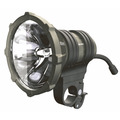
Well, there is another contender, namely the B&M Big bang, but this comes at a huge price (€729,-) and with HID technology which I don't like (the light colour is far too blue, and it's too fragile, esp. this: you can only do about 1000 on/off cycles with them, so switching it off at a traffic lamp reduces its lifespan). Output ca. 500 lumen - losses for reflector/lens, so probably about 400 lumen. Again, I'm not that interested in battery powered lamps for myself, nor am I interested in HID lamps mainly because of their light colour, so unless someone lends me this lamp, I'm not going to test it. Some comments: The Big bang is too big in my view, and for various reasons I doubt it will be better than the Philips. Also have a look at this posting on mtb-news.de. And for a picture of the beamshot see this thread: http://www.velomobilforum.de/forum/showthread.php?t=19785 which also shows you the light colour which I think is truly awful.
The light intensity as per the StVZO test method is said to be 140 lux which is a lot more than the LBL's 80 (but it was measured at 95), so throw could and should be even better than the LBL. The biggest problem is the light colour which varies from extremely blue to what in some places seems near purplish as you can in the beamshot in the thread above, also in that picture the beam's colour and brightness seems to vary quite a lot within the main part of the beam. Width of the beam appears not to be more than the LBL.
Update: After seeing Vienna's beamshots it's apparent that the Big bang's beam shape is wider than the LBL (good), that the cutoff is really strict and the beam is very bright at that point. This confirms the lux rating is very high which means it should have more throw than the LBL assuming the brightness is maintained enough below the cutoff, and it does look that way. But, the beam illumination is uneven as in the earlier beamshot, and the beamcolour is as bad as in that previous beamshot.
Supernova Airstream
Update (18 September 2010, although I knew of it a long time ago, I forgot to add this to this list earlier): Supernova will release the Airstream, a battery powered version of the E3, using XP-E R3 cool white LED in the StVZO version (or XP-G R5 in the international version) and a new lens. The beamshots on their website show a fairly similar beam to the Edelux, i.e. much narrower than the Philips LED bike light (I need a good abbreviation for that name!). The light output is probably at best similar to the Philips lamp (which has been measured at 291 lumen (with an error margin of 5%) for one sample, and 270 lumen for the very lamp that I tested; these are 'out the front figures', so minus all losses from reflector/lens). The claimed 305/370 lumen is without doubt a Cree datasheet value, which is not taking into account losses from the lens, nor that LEDs don't usually achieve what the datasheets promise (see http://www.mtb-news.de/forum/showpost.php?p=6822716&postcount=1088 for the Cree XP-G R5 to give an example, although these measurement results gives a figure of 285 lm for the XP-G R5 at 1A with losses of the lens included, perhaps the XP-G's have improved and been getting closer to datasheet values?). An earlier version of the E3 which was claimed to produce 220 lumen was measured at 160 lumen. So a figure of about 220 real lumen (perhaps 240 for the XP-G version) for the new E3 from end of 2010, and for the Airstream is more likely... For reasons mentioned on the main bicycle lighting page, I'm not going to test any Supernova lamps unless someone lends me one. Oh btw, on the IBC forum mtb-news.de someone from Supernova claimed:
Die Philips-Lampe ist vom Leuchtbild her gar nicht mal schlecht, fast so gut wie die Airstream,
aber die muss man einfach mal in der Hand gehalten haben - ultra monströs!
Das wird in den Werbebildern immer sehr gut kaschiert.
My translation: "The Philips lamp has a beam that's not bad at all, almost as good as the Airstream, but you must have held one in your hand, it's monstrously large. That's being masked quite well in the advertisement images".
My comments: Anyone who says the Philips lamp has a beam that's "not bad at all" is either being deliberately understated as a form of humour (as someone did on the candlepower forums in August 2010, I didn't recognize it then), or he is just talking bullshit, and the latter is the case. Also, the size is not being hidden, there are simply not many size comparison pictures of any lamps (with other lamps or other objects) to be found anywhere! (Supernova also doesn't show comparison pictures of their lamps with other objects, well, OK they have fairly recently added some miniscule pictures of an E3 headlamp with a small part of a bike, but nothing proper!) So this statement from him is also just bullshit. Coincidentally, I had intended to make comparison pictures of various headlamps for a while, and made a page recently with such pictures: Bicycle lamp size (comparison pictures and why a lamp needs to be a certain size). He writes in his sig that his comments are influenced by being employed by Supernova. Well, they are not influenced by that, they are more like a 'Verarschung' (taking the piss) of the readers with a totally biased view, not one that is 'influenced'. Apart from making promises again and again that they didn't keep, this sort of talk is another reason why I don't like these people from supernova. Note that when I get my hands on any Supernova lamps (I should get a E3-triple on loan soon) I will, despite not liking these people, give the lamp a fair review. It is possible to be biased towards a company, positive or negative, and still give objective results...
I doubt the Airstream in its supposed 370 lumen version is as good as the Philips LBL: look closely at supernova's beamshot and you can see the unevenness in its beam (bright near the lamp, bright in the middle, but the left and right are noticeably darker). Also it obviously doesn't put out 370 lumen but at best what the Philips LBL does.
Btw., the LEDs in the Philips LBL are driven at a conservative 0.70 A. Those of you willing to modify a lamp with a different driver such as a maxflex or b2flex can get even more light out of it, ca. 370 lumen at 1A, which would blow the Airstream away, for a lower price. I further don't believe at all that the E3 pro dynamo lamp produces 370 lumen with the XP-G, in fact, it was measured at 20 km/h to produce just 140 lumen. I don't believe it will get more than about 240 lumen at high speeds. Perhaps I'm wrong, but I'm taking this from good estimates and I'm not talking bullshit unlike the people from Supernova.
Update 2011-2-14: All the estimates that I made since August 2010 have been proved correct: The Supernova Airstream XP-G has been measured at 217 lumen, nowhere near the claimed 370 lm, and far less than the 270-291 of the Philips LBL, and due to the diverging beam and low lux rating of the Terraflux lens based Supernova lamps (see my review of the Supernova E3-pro-StVZO for more information on this), throw and illumination of the road is not going to rival the Philips LBL. The StVZO version of the Airstream produced only 175 lm. See http://www.mtb-news.de/forum/showpost.php?p=8019707&postcount=1145 (in German).
Trelock LS 950
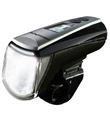
Update (18 September 2010): Trelock will release the LS 950, in January 2011. This is a battery powered lamp similar in specifications to the Philips. Interestingly they haven't put up beamshots... (On 27 Nov. I noticed beamshots were put up) Well, there is one in the video, but again as with their other lamps, the picture they show is with a cutoff above the horizon (i.e. lamp is aimed too high). Bad, bad, Trelock! Also the exposure time or ISO is much higher than in my pictures as it's rated at 70 lux (Philips 80) but the brightest spot is much brighter than the Philips in my beamshots. I doubt the Trelock will be as good as, never mind better than the Philips LBL (at least in beam shape and light output, the display and multiple level settings are nice), but we'll have to wait and see.
Update 2011-3-8: I got a report from 'Vienna' in Japan on 7 March who has the Philips LBL and Trelock LS 950 and the latter is definitely inferior: the Philips LBL is much brighter and has a much wider beam. He will make some beamshots with camera on a tripod when the weather gets better (less cold) and of course the recent earthquake doesn't help! He has some non-optimal but interesting beamshots up there, and a few other interesting pictures (esp. the size comparison Dosun D1 vs. Big bang): Vienna's bicycle lamp album
This is confirmed by a very good and detailed review on the LS950 on a German forum which was coincidentally also on 7 March: http://www.radforum.de/trelock-ls-950-stvzo-70-lux-120-a-187431.html. Is the friend who measured the LS950 by any chance Olaf Schultz? I can't imagine anyone else doing this stuff! In any event, light output on the grid (which is probably not the entire light output) is 127 lm. Current through the LED is 0.65A, this should give a lightcurrent of 243 lm according to cree but it's more likely 187 lm in reality (due to the deviations of XP-Gs from Cree's datasheets). This would give a total light output, assuming 10% optical losses, of 168 lm.
I was thinking of doing a test myself of the LS950 but now I don't see much point...
Update 2011-5-1: Beamshots of the LS950 below by 'Vienna' confirm his impressions and those on radforum.de.
Roxim RS3 & RX5
These lamps don't seem to be strong competition to any of the above but it's interesting that more manufacturers are making StVZO compliant lamps:
On the website of the Taipei cycle show (16-19 March 2011) I noticed the Roxim RS3. The picture looked interesting so I went to the Roxim website to look for the Roxim RS3 and I really like their RS3 gallery. This is much better than what other manufacturers do (such as Busch & Müller)... The beamshots are useful (I would like a straight one added, i.e. the same way as my beamshots are made), the picture with an oncoming shot of a lamp with symmetric beam and one with cutoff side by side is nice, and I like the picture where the lamp is shining on the wall (because that's relevant for the StVZO test procedure).
They also introduced a new lamp: RX5. 45 lux so still some distance to the best European lamps. Vienna has tested the RX5 and from the beamshots it doesn't look very good. The beam shap looks strange, like a bow wave (I mean a bright edge of the beam, in which there's a less bright illumination).
Vienna's beamshots
Addition 2011-4-30: 'Vienna' from Japan made a series of beamshots with the camera on a tripod, see:
http://photozou.jp/photo/list/214524/3815481
Update: More beamshots from Vienna, also with the Roxim RX5: http://photozou.jp/photo/list/214524/4445699
Here are Vienna's beamshots of the lamps that interest me most:
The hut is at 40m, the wall behind that at 50 m. Lampheight is 1.00m, camera height is 1.20m. Camera settings: ISO200, F3.2, 1.3s, which is about the same as my beamshots (ISO 80, F3.5, 4s). The surface is fairly light gray, probably lighter than the rough gray asphalt of road 2.
Pondering about the beamshots:
- Dosun D1: In the 'Bright mode' the 4 cores of the MC-E in the D1 light up, in the 'Regular mode' just 2. 'Vienna' says the range of the D1 doesn't seem as limited (I expected throw to be not very good due to low lux rating), but for me limited means ca. 45 m which is about the max range of the Edelux and Philips SLD (dynamo). And you can't really tell the range of the D1 with the given setup.
- Dosun D1: Is the D1 StVZO compliant only in the 2 core mode? I wonder because there's a lot of spill upwards in Bright-mode. This also gives some range in that mode... But how much range is hard to say. I would still say not much more than the Edelux as you can see the brightness on the ground of the D1 in Bright-mode rapidly diminishing close to the hut. The LBL is significantly brighter on the ground near the hut at 40 m distance.
Vienna took some shots of the cutoff which helped answering the cutoff question, thanks! See http://photozou.jp/photo/show/214524/78342386. It shows how the cutoff is there in both the regular and bright mode, but in quite different places! This should be an issue in the StVZO tests: Cutoff should be in the same place at different power levels as otherwise it's really cheating the system with an StVZO compliant lamp that actually has a beam that's more like a highbeam (which is not allowed for cars when there is oncoming traffic, and it's not allowed at all for bicycles).
- The D1 could be aimed higher in 2 core mode as it now doesn't reach the hut but in that case the light in Bright-mode is aimed too high so opposing traffic would really get blinded. So this is a trade-off by Vienna as you would have to do in normal use (i.e. only use Bright mode on roads with no oncoming traffic). It would still be interesting to see what the beamshot of a higher aimed D1 in 'Regular mode' would be like.
- 'Vienna' estimates the Philips LBL's range at 40 m but I think that's different interpretation of range. For me it is being able to see 'something' such as a broken off branch. 70 m is a very long way away and it's hard to see anything at that distance on the road even with much more light. The range is definitely 70m that way vs. ca. 45m for Philips SLD and Edelux. The beamshots I made with the lamps set up as I use them, show the cutoff to be at about the same position (70m for LBL, 45m for Edelux). Also note that I get about a similar range with the Betty 2011 with 16° lens in the situations I tried it, so getting more light on the road (not on trees etc.) at a distance of 70m or more is hard because roads are not fully flat, because of perspective, and the smaller angle of reflection at a greater distance.
- The Philips LBL could be aimed a bit too low, but I need to check. StVZO gives a 3.4° region in which light intensity must go down from the maximum lux to less than 2.0 lux. I think with the Philips LBL this region is brighter than with the Big bang so perhaps the LBL should be aimed higher. However, then it would put a significant amount of light in the eyes of opposing traffic. This could actually be a reason why I thought the LBL was too bright above the horizon, but to be sure I will do some tests shining it long distance at a wall. This is a an area in which I've not done enough testing. It was actually on my to do list but I couldn't do it due to circumstances from end of Jan. 2011 to early May. Update: My analysis of StVZO headlamp aiming rules and the implications of the 3.4° region made the issues more clear.
- The Big bang has a really strict cutoff! The beam is wider than that of the LBL, which is nice, but now I would really like to see what it's like in practice on a longer road. A wider beam is probably the most useful way to use more light than what the LBL produces, as you won't quickly outrun the LBL's beam! Also notable is the awful light colour: very blue, and there's an uneveness in the light colour that I already noticed in another picture (see above) Now look at the ground and you see a bit of the purple that I saw in that other picture as well. That's really bad!
- The LS950 is indeed no competition for the LBL (regarding beam quality). I read in a posting from 12 May in http://www.radforum.de/trelock-ls-950-stvzo-70-lux-120-a-187431.html (in German) that the LS950 is brighter than the LBL but from the beamshots from Vienna I don't see that. Note that a cooler white to many people gives the impression of being brighter than a more warm white beam of the same lightouput.
So, for me the question is still: How good are the Big bang and D1 compared to LBL? I think I need to do some tests with the cutoff of lamps against e.g. a wall at long distance as well.
Lux and lumen measurements (estimates) by Vienna
2011-5-29: Very good work by Vienna again, giving lumen output values calibrated using the known output of a given flashlight. The way this works is as follows:
- Take a small room, take a torch with known light output (from someone else's measurement done in a calibrated integrating sphere), shine it in the room onto a wall and measure the light output in lux with a luxmeter somewhere in the room.
- Shine another light source in the room and measure luxoutput, the lumen output of that second light is lux2/lux1 * known-lumen1.
So the room is essentially used as an integrating sphere which is calibrated using the torch of a type that was measured somewhere else. See Vienna's results here: 2011-5-29: Vienna's lux measurements and lumen estimates.
The following are all battery powered headlamps with cutoff that might be competion to the Philips LBL/Saferide 80.
- Hilight 60, see also http://www.velomobil-forum.de/forum/showthread.php?25940-Es-werde-Licht!-2-0/page18. This lamp started as a DIY project, it's quite big, and a modification of an ellipsoid lens originally for quad vehicles I believe. Really only suitable for recumbents or trikes due to size.
- If I can get a loan or can get it cheap I want to try out the Fenix BT-20... It has neutral white light but it doesn't seem to have a very sharp cutoff. Is this competition for the LBL? (Update: I had zero response from the Fenix websites in 2 months, so I'm not going to test this).
- Busch & Müller Ixon IQ [ Inferior light beam (less light, narrower beam, far smaller reach), but longer runtime ]
- Dosun D1 [ almost certainly hasn't got the reach of the LBL and will overexpose the near field (because it puts out a lot of light, and not with high lux rating, so a lot ends up close to the cyclist) ]
- Busch & Müller Big bang [ Brighter, wider longer beam but this is uneven in strength and colour, and it has a bad light colour, big, longer runtime, too fragile ]
- Supernova Airstream [ Inferior light beam (less light, far smaller reach), but longer runtime, smaller mass ]
- Trelock LS 950 [ Inferior light beam (less light, narrower beam, far cooler light colour), but more brightness settings, display with information about the battery and longer runtime ]
Philips Saferide e-bike (battery powered with cutoff) The e-bike headlamp needs to adhere to different rules than StVZO, namely ECE R113. E-bikes are electric bicycles that go without needing to pedal, and can go 40 km/h (I think). They are not allowed in all countries. The e-bike version has a smaller lamphead than the LBL (shorter as there are no internal batteries, but also less wide), uses Altilon LEDs and I'm curious how good the beam is. Early 2012 it was to be OEM only, but there was a possibility of making it available for sale on the aftermarket.
2013-4-17: I was supposed to get one for testing early 2012, but I still don't have a testlamp and it seems it's not going to be on sale loose. I'm not sure what Philips is going to do with it or if there will be further developments... 2013-6-27: I haven't heard anything about this lamp any more, so I'm going to leave it at this.
No longer made, not sure when, but Philips stopped with all bike lamps early 2014.
2012 Aug/Sept: Philips: Active ride, for MTB+road. Philips' website. I'm not sure about reviewing this. The beamshape from reports I've seen is far inferior to the Saferide 80, and the claimed lux rating is also a lot lower at 50 lux which means the reach has to be a lot less. The lamp can switch to a non-cutoff MTB beam which makes it a product that could be interesting for those who ride both in the city and on unlit country roads with little oncoming traffic.
2013-12-18: Vienna made pictures of various lamps and those of the Activeride show that the criticism that I read that said that the beam isn't nearly as good as that of the Saferide 80, is correct (I hadn't seen any pictures of the beam yet before seeing his beamshots). The beam clearly isn't as even and what I don't like either is the variation in light colour within the beam. If I had tested the lamp I would strongly criticise this, so possibly that's why Philips didn't send me a sample to test ;-)


No longer made, Philips stopped with all bike lamps early 2014.
Last modified: Fri Dec 14 20:20:11 CET 2012











